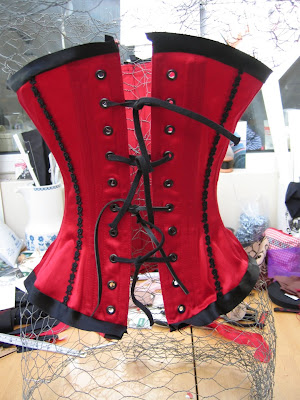
Making a corset takes time and precision, but as long as care is taken over each step, it's not difficult. Today I spent time on the bone channels which are placed over the seams. It took all afternoon just to do one side of the corset, but I am pleased with the results.
The pattern instructions say that the seams should be 'flat felled' and then the boning tape sewn on, but this leads to a very messy effect on the right side, so I don't follow the instructions to the letter. Here is an example - this is the very first corset I ever made (with the Simplicity pattern) - I've kept it for reference!
You can see how wiggly the lines are, and how messy it looks. So what I do now, is trim one side of the seam right down, then fold the other side over it - like a flat felled seam, but then I baste the boning tape right over it, and sew in one step.
It would ofcourse be much easier to press the seam open and sew the tape over that, but this method would not result in a very strong seam - these seams have to take a lot of pressure! The last thing I want is for them to burst open while I'm wearing it!!! That just wouldn't do now would it! ?
I line the boning channel up over the folded seam, and just over the original seam line so that I can 'stitch in the ditch' from the right side, catching just enough of the tape...
I know that when I turn the corset around to sew the other side of the channel, if I line the left side of my presser foot up with the line I have just sewn (in this case, the 'ditch'), the needle is in exactly the right position to sew the exact width I need in order to be able to slide the bone in very snugly.
Here's what it looks like on the other side - and you can see that i've finished off the outer edge by placing bone tape over the back facing to give a neat finish.
The finished side is then zigzagged on the top edge so that it doesn't fray, and the bottom edge is left open so that I can slide the bones in.
I will sew the bone channels on the other side tomorrow, in the same manner, then add some more eyelets to each side, insert the bones, bind the tops and bottoms with bias binding, and embellish.






















